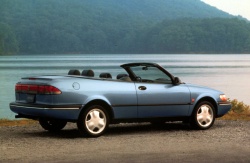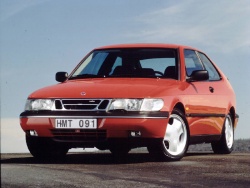 1998 Saab 9-3 five-door. Click image to enlarge |
|
Related articles on Autos
|
By Chris Chase
Find this vehicle in Autos’s Classified Ads
Saab might be the quintessential car for those who love weird stuff. Remember the 99 and 900 models, with their upright windshields? Then there’s the ignition switch located on the centre console, where most Saab models still have it to this day.
But behind those eccentricities were comfortable cars that owners say are damn fun to drive. In 1993, Saab launched its first new model since General Motors took a 50 per cent ownership of the Swedish company in 1990. That car was the then-latest 900 model, referred to by Saab-o-philes as the “new-generation” NG900. In its first year (1994), the 900 convertible remained on the previous-generation platform, while the NG900 was offered in three and four-door hatchback forms. A new convertible arrived in 1995. In 1999, Saab ditched its well-known 900 nomenclature for 9-3, and while Saab claimed more than 1,000 “improvements,” you’d be hard-pressed to tell the newly-named cars apart.
 1998 Saab 9-3 five-door. Click image to enlarge |
Initially, the “new” 1994 900 was offered with either a 2.3-litre four-cylinder (150 hp) or a 2.5-litre V6 (170 hp); conspicuous by its absence was a turbocharged engine, which would appear again in 1995, and was rated at 185 hp. The V6 disappeared in 1998; in 1999, a high-output turbo motor was offered in uplevel SE models, offering 200 hp. That more powerful motor got another bump to 205 horses in 2000. The Viggen model arrived for 2001, with a turbocharged version of the 2.3-litre four-banger making 230 horsepower. Fuel consumption figures range from a little more than 11.0 to about 13.0 L/100 km (city) and between 8.0 and 9.0 L/100 km (highway), with the higher numbers generally going to models with turbocharged engines and automatic transmissions.
 1998 Saab 9-3 five-door. Click image to enlarge |
Where reliability is concerned, many enthusiasts – as they tend to do – swear the NG900 and early 9-3 is a reliable car – more so, at least, than other European makes could claim. Based on what I can find on the web, that seems like it might be true. What’s certain is that a non-turbo model with a manual transmission would be your best bet for low(er) maintenance costs, if not better dependability. According to the used NG900/9-3 buyer’s guide at SaabCentral.com, things to look out for include oil leaking from the engine head gasket; a high-pitched whine from the engine indicates accessory belt idler pullies that are on their way out, and a rattling sound at about 3,000 r.p.m. that means possibly worn timing chains which necessitates removing the engine to replace them. In turbo models, the Direct Ignition module is known to fail but is easily replaced. Many Saab enthusiasts suggest simply buying an extra before you need it and keeping it in the car. Also, turbo cars in general require more frequent-than-usual oil changes, and it’s suggested that the engines in these cars are capable of running for many years with proper maintenance.
I couldn’t find a whole lot of information about the automatic transmissions in these cars (though the four-speed automatic seems to be a decent unit), but there are a few things to know about manual transmission cars, says SaabCentral.com. Early models (1994 and 1995) had gear linkage problems that manifested as difficulty shifting into reverse and/or second gear. The shifter should not be able to move out of reverse without the key in the ignition, and watch for transmission fluid leaks around the gear selector shaft.
 1998 Saab 9-3 five-door. Click image to enlarge |
Saab offered a novel transmission option in its Sensonic automatic clutch system. These cars had a normal-looking manual shifter, but the clutch was electronically actuated. It’s unlikely you’ll find many of these kicking around on used-car lots, but I’d advise avoiding one if you do find one: according to SaabCentral.com, it’s expensive to repair.
Despite how rosy a picture the Internet paints for these cars, I suspect there’s more to the story. So does Consumer Reports, which rates the 9-3 (data from 1999-on) as well below-average in terms of reliability; electrical problems are the biggest culprit. Here’s a link to a good thread at SaabCentral.com, listing many common issues with the NG900 and 9-3.
Safety-wise, the National Highway Traffic Safety Administration (NHTSA) gave the 900 and 9-3 four stars each for driver and front passenger protection in frontal impacts. The 900 earned a “marginal” rating from the Insurance Institute for Highway Safety (IIHS), while the later 9-3 got a slightly better “acceptable” rating. Neither organization tested the NG900 or 9-3 for side impact safety.
 1998 Saab 9-3 five-door. Click image to enlarge |
Canadian Black Book only publishes values as far back as 1997, and values for this small Saab range from $4,225 for a 1997 900 two-door, to $12,075 for a 2002 9-3 Viggen four-door. Note that a 1998 900 is actually worth more than a 1999 9-3; perhaps this is due to the loss of the 900’s name recognition. Regardless, these Saabs are worth much less than a comparable BMW 3 Series or Audi A4, which might make the Swedish car even more attractive combined with its relative uniqueness. While low prices make the 900 and 9-3 a great deal for a nice car, but the downside is these cars’ finicky nature. If you do choose a 900 or 9-3, I’d advise familiarizing yourself with the more common problems (the links in the Online Resources section will be a big help here) and look for a car with spotless maintenance records that check out with a trusted mechanic.
|
Pricing
Black Book Pricing (avg. retail) February 2010:
Online resources
Recalls
1994: The front brake discs and/or pads can be coated with a layer of slush, road salt or water while driving in snow or heavy rain. This can result in a short delay in braking action that increases the normal braking distance. Correction: the front brake shields will be replaced with ones of a new design to improve the protection of the inner brake pads and discs.Transport Canada Recall Number: 1994121; Units affected: 187 1994: There is a risk of fatigue cracks around the attachment bushings on the height adjusting mechanism in the driver’s seat. In the event of a rear end collision, the height adjuster could break and allow the seat to fold down rearward. Correction: dealers will replace the seat rails, on the driver’s side, with new ones.Transport Canada Recall Number: 1998163; Units affected: 4,340 1994-1998: These vehicles do not comply with c.m.v.s.s. 108 – lighting system and retroreflective devices. The section titled “headlamp aiming” was omitted from the owner’s manual. Correction: dealers will insert a page supplement in the owner’s manual containing the instructions on headlamp aiming. Transport Canada Recall Number: 1995028; Units affected: 671 1994-1995: Note: 1994-95 3 and 5 door models and 1995 convertibles. The seat assemblies may be missing one or more of the arc welds that join the seat back recliner mechanism to the seat back frame. This could result in the seat back falling backwards if the vehicle is impacted from the rear. Sudden failure of a driver seat back could occur without prior warning and cause the driver to lose control, resulting in a possible crash. Correction: seat backs will be inspected and replaced if required. Transport Canada Recall Number: 1997099; Units affected: 2,454 1994-1997: Note: vehicles with 4-cylinder engines. The zinc-coated throttle control lever bushings in the throttle housing may corrode, causing the throttle lever to bind. This could result in the throttle plate not returning to the closed position when the accelerator pedal is released and a subsequent loss of throttle control. Correction: zinc-coated throttle lever bushing in the throttle housing will be replaced with a nickel-coated bushing and bolt. Transport Canada Recall Number: 1995136; Units affected: 575 1994-1995: Note: vehicles equipped with manual transmission include 1995 Saab 900 convertibles. Defect: it is possible under certain parking conditions to move the shift lever into the reverse gear position, remove the ignition key, and still have the transmission in neutral, or, to accidentally disengage reverse by striking the shift lever. If the hand brake is not applied, it is possible to have the car roll from its original parked position. Correction: two washers will be replaced and the shift linkage will be adjusted. 1995: Note: vehicles with 2.3-litre engines and Bosch Motronic 2.10.3 engine control modules. Defect: it is possible that an internal voltage drop can result in an intermittent fluctuating idle. This up-down idling may occur during the first 10-30 seconds after restarting the vehicle with a warm engine. Correction: affected engine control modules will be replaced. Transport Canada Recall Number: 2002212; Units affected: 940 1995: On certain vehicles, an electrical short within the airbag electronic control unit may cause inadvertent deployment of the front airbags and seat belt pretensioners. Correction: Dealers will replace the airbag electronic control unit (ECU). Note: parts will not be available until April 2003. Transport Canada Recall Number: 1996070; Units affected: 30 1996: Note: 5 door vehicles. These vehicles do not comply with c.m.v.s.s. 210 – seat belt assembly anchorages. Vehicles were assembled with a non heat treated outboard attachment plate on the safety belt which could in certain circumstances deform and detach from the seat anchorage. Correction: front seat belts will be inspected and replaced if necessary. 1998: Certain passenger vehicles. Static electricity can build up within the passenger-side air bag module and create significant enough charge to cause an inadvertent air bag deployment during triggering events. Most of these triggering events have occurred in cooler, dry weather and have generally included dusting or wiping of the dashboard, starting the car, or closing the door. Unexpected air bag deployment can result in occupant injury. Correction: Dealers will install a front passenger-side air bag module grounding strap. Transport Canada Recall Number: 1996046; Units affected: 192 1995: The steering column shaft may have been misaligned at the time of installation. This misalignment could cause a fatigue failure in one section of the shaft, with a subsequent loss of steering control. Correction: dealers will inspect and/or replace the steering column assembly. Transport Canada Recall Number: 2005271; Units affected: 4,589 2000-2002: Certain 2000-2002 Saab 9-3 and 9-5 model vehicles equipped with 4-cylinder gasoline engines, and 2001-2003 9-5 models equipped with 6-cylinder gasoline engines may experience overheating and burnout of the Isolated Gated Bipolar Transistor (IGBT) within the Ignition Discharge Module (IDM) due to increased susceptibility to electrical loads. Overheating of the IGBT occurs most often at engine start-up but may also occur while the engine is running. When the IDM fails on a 4-cylinder while it is running, the engine may stall without warning, with no ability to be restarted. When the IDM fails on a 6-cylinder engine while it is running, the driver will initially experience reduced power and rough operation because the engine will only be running on three cylinders. The check engine light will flash. If the driver continues, unburnt fuel in the exhaust can cause thermal damage to the catalytic converter. The engine may stall and not restart. Correction: Dealers will inspect and, if required, replace the IDM. Transport Canada Recall Number: 2002095; Units affected: 4,589 2002: On certain vehicles the brake calipers have received the wrong surface treatment. As a result, when the brake caliper becomes hot, hydrogen gas can form, diminishing braking performance. Correction: Dealers will inspect and replace calipers if necessary. Transport Canada Recall Number: 2001235; Units affected: 15 2002: Certain passenger vehicles the tie rod end retaining nuts may not have been properly tightened at the factory. The nuts could loosen and fall off resulting in a sudden reduction or loss of steering control. Correction: All vehicles will be inspected and corrected prior to customer delivery. No owner notification will be required. Transport Canada Recall Number: 1999167; Units affected: 95 1999: On certain vehicles, a failure of the “Easy Entry” cable in the front driver or passenger manual seats can cause the seat fore/aft adjustable mechanism to be unlocked. Correction: Dealers will install a new cable and spring assembly. Transport Canada Recall Number: 2007059; Units affected: 4,033 2000 and 2003: On certain vehicles, the fuel pump retaining tabs holding the fuel lines were damaged during production. Over time, this could cause the fuel lines to loosen from the pump resulting in fuel leakage. If an ignition source were present, the fuel may ignite resulting in a vehicle fire. Correction: Dealers will install a bracket that will secure the fuel lines to the fuel pump even if the plastic retaining tabs should break. Transport Canada Recall Number: 2006095; Units affected: 808 2001: On certain vehicles, the fuel pump retaining tabs holding the fuel lines were damaged during production. Over time, this could cause the fuel lines to loosen from the pump resulting in fuel leakage. If an ignition source were present, the fuel may ignite resulting in a vehicle fire. Correction: Dealers will install a bracket that will secure the fuel lines to the fuel pump even if the plastic retaining tabs should break. Transport Canada Recall Number: 2004427; Units affected: 381 2001-2002: On certain vehicles, the fuel pump retaining tabs holding the fuel lines were damaged during production. Over time, this could cause the fuel lines to loosen from the pump resulting in fuel leakage. If an ignition source were present, the fuel may ignite resulting in a vehicle fire. Correction: Dealers will install a bracket that will secure the fuel lines to the fuel pump even if the plastic retaining tabs should break.
Crash test results
Used vehicle prices vary depending on factors such as general condition, odometer reading, usage history and options fitted. Always have a used vehicle checked by an experienced auto technician before you buy. For information on recalls, see Transport Canada’s web-site, www.tc.gc.ca, or the U.S. National Highway Transportation Administration (NHTSA)web-site, www.nhtsa.dot.gov. For information on vehicle service bulletins issued by the manufacturer, visit www.nhtsa.dot.gov. For information on consumer complaints about specific models, see www.lemonaidcars.com. |







 Follow Autos on Twitter
Follow Autos on Twitter



